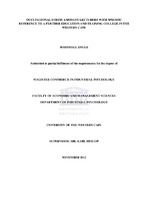| dc.description.abstract | Research on stress has indicated that people in the helping professions dealing with people, especially those in the teaching profession, are particularly prone to emotional distress. However, information regarding the stress-related emotions specifically experienced by academic lecturers at institutions of Further Education and Training is not abundant. University teaching has traditionally been conceived of as a relatively stress-free occupation, or at least has been seen in this way by outsiders. Nevertheless, there is overwhelming evidence attesting to the fact that academia is a highly stressful occupation.The contemporary academic context in South Africa is characterised by changes such as the incorporation of colleges and the merging of universities and technikons, now referred to as universities of technology. Consequences such as financial predicaments, insecurity of employees, short-term contract positions, fewer fringe benefits, increasing emotional disturbance and stress, are unavoidable. Although they are not highly paid in comparison to professionals in the commercial sector, academics have been envied for their tenure, light workloads, flexibility and freedom to pursue their own research.Concerns about academic stress have been articulated over the past three decades. Research conducted in the United Kingdom (UK), United States of America (USA), Australia and New Zealand has identified several key stressors commonly associated with stress among academic staff. These include work overload, time constraints, lack of promotion opportunities, inadequate recognition, inadequate salary, changing job role, inadequate management and/or participation in management, inadequate resources and funding and student interactions. Other sources of stress, such as high self-expectations, poor interactions with colleagues, inequality in the system and lack of regular performance feedback have been highlighted in a few studies. Although some studies found high levels of stress relating to work relationships, control, resources and communication and job insecurity, excessive overload and work-life imbalance are among the most frequently reported stressors by academics. Since academics do not represent an homogeneous group of professionals, it is considered inappropriate to examine academic stress without taking all their professional and personal characteristics into account. Research has shown that workload, inadequate salaries and a lack of public recognition were perceived as more significant sources of pressure by men than by women, whilst job insecurity, isolation from colleagues, a lack of institutional recognition of worth and work politics were more salient for women. Since academia is still largely a male dominated occupation, female academics may experience more stressors and strains than their male counterparts due to a lack of role models, less socialisation from women from their own rank, gender stereotypes and increased role conflict as they endeavour to balance roles at work and at home. Researchers have also noted the importance of age-based differences, and conventionally believe that stress universally declines with chronological age.Data was collected through a biographical questionnaire and the Experience of Work and Life Circumstances Questionnaire (WLQ). A convenience sample of lecturers in an FET College (n=150) completed the questionnaires, which were analysed using the Statistical Package for the Social Sciences (SPSS), version 20. Statistical procedures for data analysis include: T-Test, Multiple Regression Analysis and Analysis of Variance (ANOVA).The results in the current research reveal that there are statistically significant differences in stress levels of academic staff at the FET college based on gender, age, race, marital status and tenure. Based on the responses obtained, 35.33% of the variance in total stress could be explained by Organisational functioning, Task aspects, Salary, benefits and personnel policies, Extra-organisational factors and Career aspects, and suggest that other unexplored variables could explain the variance in stress levels experienced by academics at the FET college. | en_US |

